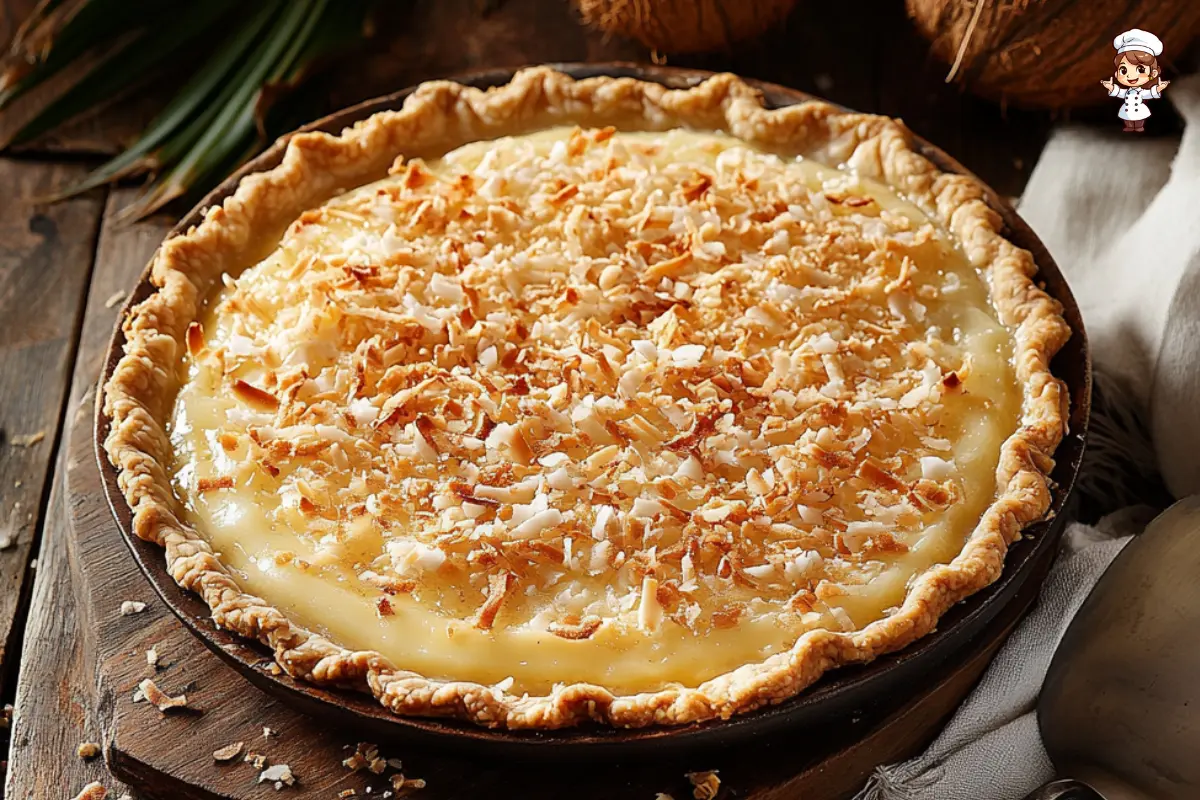A coconut pie recipe is more than just a dessert; it’s a slice of comfort that combines rich, creamy textures with the tropical allure of coconut. Whether you’re a pie-making pro or someone trying their hand at baking for the first time, this guide has everything you need to create a coconut pie that will impress any crowd. We’ll cover everything from choosing the best ingredients to mastering the art of serving and storing your creation. Let’s dive into the world of this beloved dessert!
What is a Coconut Pie?
At its core, a coconut pie recipe is a decadent dessert made with a rich, creamy filling featuring coconut as the star ingredient. Often nestled in a buttery crust, coconut pie combines sweetness, nuttiness, and a hint of tropical flair. It’s a versatile dish that can be dressed up with whipped cream, toasted coconut, or even fruit toppings.
Why Coconut Pies Are Loved Worldwide
Coconut pies have carved a special place in dessert menus globally. Their unique flavor profile—both sweet and slightly nutty—makes them a standout choice for those seeking a twist on traditional fruit pies. Plus, the creamy filling paired with a flaky crust creates a textural contrast that’s simply irresistible.
The History of Coconut Pies and Desserts
Coconut pies trace their roots back to tropical regions where coconut was abundant. Over time, they became a Southern favorite in the United States, earning a spot in holiday feasts and family dinners. Today, recipes like coconut cream pie or Southern-style coconut pie celebrate the ingredient’s versatility, bringing smiles to pie lovers everywhere.
With this introduction, you’re ready to explore the essential ingredients and variations that make a coconut pie extraordinary.
Print
Classic Coconut Pie Recipe
- Total Time: 2 hours 10 minutes
- Yield: 8 servings
Ingredients
For the Crust:
– 1 ½ cups all-purpose flour
– ½ cup unsalted butter, chilled and cubed
– ¼ tsp salt
– 3-4 tbsp ice-cold water
For the Filling:
– 1 cup shredded coconut (sweetened or unsweetened)
– 1 cup granulated sugar
– 3 large eggs
– 1 cup milk (or coconut milk for extra flavor)
– 1 tsp vanilla extract
– ¼ cup melted butter
– 2 tbsp all-purpose flour (or cornstarch)
– A pinch of salt
For Garnishing:
– ¼ cup toasted shredded coconut
Instructions
Step 1: Make the Crust
1. Combine flour and salt in a bowl. Cut in chilled butter using a pastry cutter or fork until the mixture resembles coarse crumbs.
2. Gradually add ice-cold water, 1 tablespoon at a time, mixing until the dough comes together.
3. Form the dough into a disk, wrap it in plastic wrap, and refrigerate for at least 1 hour.
4. Roll out the chilled dough on a floured surface to fit a 9-inch pie dish. Press it into the dish and trim the edges.
Step 2: Prepare the Filling
1. In a large bowl, whisk together sugar, eggs, milk, melted butter, vanilla extract, flour, and salt until smooth.
2. Fold in shredded coconut and mix well.
Step 3: Assemble and Bake
1. Preheat your oven to 350°F (175°C).
2. Pour the filling into the prepared pie crust, spreading it evenly.
3. Bake for 45–50 minutes, or until the filling is set and the top is golden. Check halfway through and cover the edges with foil if they brown too quickly.
Step 4: Cool and Garnish
1. Let the pie cool completely before slicing.
2. Garnish with toasted shredded coconut for added texture and flavor.
Latest Amazon Finds
Notes
Serve this coconut pie recipe chilled or at room temperature. Pair it with whipped cream or vanilla ice cream for a delightful treat. Enjoy! 🥥🥧
- Prep Time: 20 minutes
- Cook Time: 50 minutes
Key Ingredients for the Perfect Coconut Pie
Essential Ingredients for a Traditional Coconut Pie Recipe
A stellar coconut pie recipe starts with the right ingredients. At the heart of this dessert is shredded coconut, which lends both texture and flavor. Sweetened or unsweetened coconut works, depending on your desired sweetness level. For the filling, you’ll need a creamy base made from eggs, sugar, milk (or cream), and butter. Vanilla extract adds depth, while a pinch of salt enhances the flavors.
For the crust, you can use a store-bought version, but a homemade buttery, flaky crust takes the pie to the next level. It’s worth the extra effort to craft something special for your coconut masterpiece.
Using Fresh Coconut vs. Packaged Coconut
Fresh coconut adds unparalleled flavor to your coconut pie recipe. If you’re up for the challenge, cracking a coconut and grating the meat gives the filling a tropical edge. However, packaged shredded coconut is a more convenient and widely available option. Toasting the coconut slightly before adding it to your pie intensifies its nutty flavor.
Creative Substitutions and Enhancements
Want to shake things up? Replace regular milk with coconut milk or coconut cream for a richer, more authentic taste. Add a splash of rum or almond extract for a sophisticated twist. If you prefer a less sweet pie, reduce the sugar or use a mix of brown sugar and granulated sugar for a caramel-like depth.
Types of Coconut Pies and Their Unique Variations
Classic Coconut Pie vs. Coconut Cream Pie
Though similar in name, these pies are distinct. A classic coconut pie recipe often includes a baked custard-like filling, firm yet creamy. On the other hand, coconut cream pie boasts a silky filling made by cooking coconut custard on the stovetop and layering it into a pre-baked crust. Both options shine, but your choice depends on the texture you prefer.
Regional Favorites: Southern and French Coconut Pies
Southern-style coconut pies are known for their rich, indulgent flavors and traditional ingredients like buttermilk and shredded coconut. These pies are often baked until the filling sets, creating a custard-like consistency. In contrast, French coconut pies lean lighter, with hints of almond extract or subtle citrus flavors, showcasing a more delicate balance.
Specialty Variations: Gluten-Free and Vegan Coconut Pie
Dietary preferences don’t mean you have to miss out on this dessert! For a gluten-free option, substitute the traditional crust with almond flour or oat flour crusts. Vegan versions can use coconut cream, cornstarch, and plant-based butter to replicate the creamy filling. These adjustments keep your coconut pie recipe just as delightful and accessible to everyone.
Step-by-Step Guide to a Delicious Coconut Pie Recipe
Preparing the Perfect Crust: Store-Bought or Homemade?
The crust is the backbone of any coconut pie recipe. For convenience, a store-bought crust works fine, but if you’re aiming for a flaky, buttery base, a homemade crust is the way to go. Combine flour, salt, butter, and cold water to create a dough. Chill it for at least an hour, then roll it out evenly to fit a 9-inch pie dish. Whether store-bought or homemade, blind-bake the crust for 10 minutes to prevent sogginess.
Making the Coconut Filling from Scratch
The filling is the heart of this dessert. Start by whisking together eggs, sugar, milk (or coconut milk for added richness), vanilla extract, and a pinch of salt. Fold in shredded coconut, ensuring it’s evenly distributed. For a creamier texture, consider blending a portion of the coconut mixture before adding it to the rest. This simple trick enhances the smoothness of your coconut pie recipe.
Assembling and Baking Your Pie
Pour the coconut mixture into the prepared crust, spreading it evenly. To elevate the flavors, sprinkle a layer of toasted coconut on top before baking. Bake the pie at 350°F (175°C) for 40–50 minutes or until the filling is set and slightly golden. Check halfway through and cover the edges with foil if they brown too quickly.
Achieving a Golden, Flaky Crust Every Time
A pro tip for achieving a perfect crust is to brush the edges with an egg wash before baking. This gives the pie a beautiful golden finish that looks as good as it tastes. Let the pie cool completely before slicing to ensure the filling sets properly.
For more baking inspiration, check out the Coconut Cream Pie Recipe for another twist on this classic dessert.
Tips for Serving and Presenting Coconut Pie
Pairing Coconut Pie with Other Flavors and Drinks
Coconut pie pairs wonderfully with a variety of flavors. A dollop of whipped cream or a scoop of vanilla ice cream is a classic choice. For a more tropical flair, garnish with fresh fruit like pineapple or mango. Pair your dessert with a cup of coffee, tea, or even a light dessert wine for a sophisticated touch.
Garnishes to Elevate Your Coconut Pie
Elevate your coconut pie recipe with eye-catching garnishes. Sprinkle toasted coconut flakes on top for a hint of crunch. Shaved white chocolate adds a luxurious touch, while a drizzle of caramel sauce complements the pie’s sweetness. These small additions make your pie not only taste better but also look stunning.
How to Slice and Serve for Maximum Appeal
To serve like a pro, use a sharp knife dipped in hot water and wiped clean between cuts. This ensures clean, precise slices. Place each slice on a dessert plate and add garnishes just before serving. These simple tips turn your homemade pie into a bakery-quality dessert.
Storing Coconut Pie Properly
Refrigerating Coconut Pie to Maintain Freshness
After you’ve savored your delicious coconut pie recipe, it’s important to store any leftovers correctly. To keep the pie fresh, cover it tightly with plastic wrap or aluminum foil. Then, place it in the refrigerator. This method helps maintain the pie’s freshness for up to four days. Moreover, refrigerating prevents the creamy filling from spoiling while keeping the crust flaky.
Best Ways to Freeze Coconut Pie for Later
If you wish to enjoy your coconut pie recipe at a later date, freezing is an excellent option. First, wrap the pie securely in plastic wrap, ensuring no air can enter. Next, add a layer of aluminum foil for extra protection against freezer burn. Then, place the pie in the freezer, where it can stay good for up to two months. When you’re ready to indulge, thaw the pie overnight in the refrigerator.
How to Reheat Coconut Pie Without Losing Flavor
Reheating your coconut pie recipe is simple and keeps it tasting fresh. Preheat your oven to 300°F (150°C). Remove any plastic or foil wrapping from the pie. To prevent the crust from over-browning, cover the pie loosely with aluminum foil. Then, heat it in the oven for about 15 minutes or until warmed through. This gentle reheating method ensures the filling remains creamy and the crust stays crisp.
Common Mistakes and How to Avoid Them
Preventing a Runny Coconut Pie Filling
One common issue when making a coconut pie recipe is ending up with a runny filling. To avoid this, make sure to use the correct amount of thickening agents like cornstarch or flour. Additionally, cook the filling until it reaches a pudding-like consistency before pouring it into the crust. Moreover, allowing the pie to cool completely after baking helps the filling set properly.
Avoiding a Soggy Bottom Crust
A soggy bottom crust can ruin your coconut pie recipe. To prevent this, consider blind baking the crust. This involves baking the crust alone for about 10 minutes before adding the filling. Furthermore, brushing the crust with a beaten egg white creates a barrier that keeps moisture out. Also, ensure the filling isn’t overly hot when you add it to the crust.
Getting the Perfect Balance of Sweetness
Achieving the ideal sweetness in your coconut pie recipe is crucial for flavor balance. Too much sugar can overpower the coconut, while too little can make the pie taste bland. To get it just right, taste the filling before baking and adjust the sugar accordingly. Additionally, remember that sweetened shredded coconut adds extra sweetness, so you might need to reduce the added sugar if using it.
FAQs About Coconut Pie
What’s the Best Type of Coconut for Pie?
When making a coconut pie recipe, the type of coconut you choose greatly affects the flavor and texture. Sweetened shredded coconut is the most common option, offering a chewy texture and balanced sweetness. If you prefer a more natural taste, unsweetened shredded coconut or freshly grated coconut works well. Toasting the coconut lightly enhances its nutty flavor and adds a slight crunch.
Can Coconut Milk Be Used Instead of Dairy?
Absolutely! Coconut milk or coconut cream can replace traditional milk or cream in your coconut pie recipe. This substitution not only boosts the pie’s coconut flavor but also makes the recipe dairy-free, perfect for those with dietary restrictions. However, keep in mind that coconut milk is thinner than heavy cream, so you may need to add a thickening agent like cornstarch for the filling to set properly.
How Do I Make My Coconut Pie Filling Thicker?
To thicken your coconut pie recipe filling, use cornstarch or all-purpose flour. Be sure to whisk these ingredients into the liquid thoroughly to avoid lumps. Cooking the filling on the stovetop until it’s thickened to a pudding-like consistency is key. Additionally, letting the pie cool completely before slicing ensures the filling sets firmly.
Conclusion and Final Thoughts
Why Coconut Pie is the Perfect Dessert for Any Occasion
A well-made coconut pie recipe is a timeless dessert that fits any occasion, from casual family dinners to festive celebrations. Its creamy, flavorful filling paired with a flaky crust makes it an irresistible treat that never goes out of style. Plus, the versatility of coconut pie allows you to tailor it to suit your preferences, whether it’s adding unique garnishes or adjusting the sweetness.
Experimenting with Flavors and Techniques
Baking is an art, and your coconut pie recipe is the perfect canvas to explore new ideas. Whether you swap in coconut cream, add a splash of almond extract, or top it with fresh fruit, there are endless ways to make the recipe your own. Additionally, experimenting with crust types, such as graham cracker or almond flour crusts, can add a unique touch.
Bringing the Joy of Baking Coconut Pie to Your Table
Baking a coconut pie recipe is more than just creating a dessert; it’s about sharing a homemade treat filled with love and care. With this guide, you have all the tips and techniques needed to craft a pie that’s not only delicious but also a showstopper on any table. Happy baking! 🥥🥧



